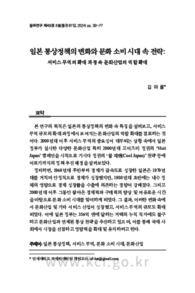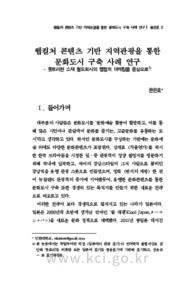

PARTNER
검증된 파트너 제휴사 자료
‘쿨 재팬’과 일본화 (“Cool Japan” and Japanese Style Paintings)
한국학술지에서 제공하는 국내 최고 수준의 학술 데이터베이스를 통해 다양한 논문과 학술지 정보를 만나보세요.
26 페이지
최초등록일 2025.07.13
최종저작일
2019.02

-
미리보기
서지정보
· 발행기관 : 서울대학교 일본연구소
· 수록지 정보 : 일본비평 / 20호 / 16 ~ 41페이지
· 저자명 : 아라이 게이
초록
일본 정부가 추진하고 있는 경제문화정책인 ‘쿨 재팬’전략은 아웃바운드와 인바운드의 창출을 목적으로 하는 것으로, 일본의 만화, 애니메이션, 게임을 중요한 아이템으로 자리매김함과 동시에 그것들의 역사적 근거로서 우키요에(浮世絵)와 이토 자쿠추(伊藤若冲)라는 에도시대의 회화를 이용하고 있다. 2000년에 개최한 《자쿠추전(展)》으로 시작되는 ‘일본미술 붐’도 ‘쿨 재팬’전략의 방향성과 겹쳐있다.
한편, ‘쿨 재팬’전략은 메이지시대에 새로운 국가의 회화로서 성립한 ‘일본화’를 다루지는 않는다. ‘일본화’는 일본미술의 한 장르로서 발전하여 고도경제성장기와 버블경제시대에는 미술시장의 총아가 되었다. 그러나 국내완결형의 시장을 기반으로 해 온 ‘일본화’는 해외의 평가를 중시하는 ‘쿨 재팬’전략의 아이템이 되지도 못하고, 국내 경제의 침체와 함께 존재감이 옅어지고 있다.
그러한 근년의 ‘일본화’에는 만화나 애니메이션, 게임의 영향을 받은 일러스트적인 화풍이 유행 하고 있다. 2000년에 무라카미 다카시(村上隆)가 기획한 《SUPER FLAT》전과 2006년에 도쿄도(東 京都)현대미술관에서 열린 《MOT 애뉴얼 2006 No Border ‘일본화’에서/‘일본화’로》(MOTアニュア ル2006 No Border「日本画」から/「日本画」へ)전이 새로운 미술 현장의 문을 열었다. 2000년 이후에 나타난 새로운 ‘일본화’ 화가들은 기존의 ‘일본화’에 대한 안티테제를 주창하고 있지 않음에도 ‘일본화’의 조류를 크게 변화시키고 있다. 그들은 ‘일본화’라는 장르나 역사에 구애받지 않고, 자기 자신과 지금을 표현하고 있다. ‘일본화’가 전통성과 근대성의 양립을 부과받은 ‘이중 구속’(double bind)의 회 화라면, 2000년 이후에 나타난 새로운 ‘일본화’는 이미 ‘일본화’가 아니라는 것이 된다. ‘일본화’라는 회화의 150년간에 이르는 고투는 어떤 치하도 받지 못하고 녹아버리듯 끝나려 하고 있다.
그러한 ‘일본화’에 대해 우려되는 문제는 만화나 애니메이션, 게임이라는 서브컬처(팝 컬처)의 세례를 받은 회화가 ‘쿨 재팬’전략 안에서 새로운 ‘일본화’의 명칭이 붙은 상품으로 여겨지는 일이다. 지금 ‘일본화’에 관하여 생각해야 하는 것은 ‘일본화’가 내포해 온 딜레마와 딜레마에 마주해 온 일의 의미이다. 대외전략인 ‘쿨 재팬’이 일본국민의 내셔널리즘을 고양시키는 것으로만 기능하고, 밖의 시 선을 의식하지 못하게 되는 상황을 일으켜서는 안 된다. 1970년에 ‘기상’(奇想)이라는 카운터컬처로 서 발견된 자쿠추 회화는 2000년대의 메인컬처로 변하였다. 일본 국내에 붐을 일으킨 자쿠추 회화를 ‘쿨 재팬’이나 ‘자포니슴’이라는 말로 자화자찬하기 전에 자쿠추 회화를 비롯한 일본미술이 해외에서 어떻게 평가받을지 객관적으로 주시해나가는 자세가 필요하다.영어초록
The Japanese government has been promoting the “Cool Japan” strategy as economic and cultural policies for the purpose of creating outbound and inbound cultural assets. As a part of this strategy, the Japanese government designated Japanese comics, animated works, and games as important cultural assets with Ukiyo-e and paintings from the Edo era, including those by Jyakuchu Ito, as their historical forerunners. The boom in Japanese art starting from the Jyakuchu Exhibition in 2000 overlaps with the direction of the “Cool Japan” strategy.
In the “Cool Japan” strategy, Japanese style paintings that were established as new national paintings in the Meiji era have not been considered. Japanese style paintings have evolved as a category of Japanese art and became a favorite of the art market during the years of rapid economic growth and the bubble economy. However, Japanese style paintings are valued on the basis of the Japanese market and were not targeted in the “Cool Japan” strategy, in which evaluation by the overseas market is emphasized. Thus, the presence of Japanese style paintings has weakened along with the stagnation of the Japanese economy.
An illustrative style of painting influenced by Japanese comics, animated works, and games has been popular in recent Japanese style paintings. The 《Superflat》 exhibition organized by Takashi Murakami in 2000 and the 《MOT Annual 2006, No Border — From Nihonga to Nihonga》 exhibition held at the Museum of Contemporary Art Tokyo in 2006 heralded a new art scene. The painters of contemporary Japanese style paintings have been playing an active role since 2000 and are beginning to change the trend of Japanese style paintings, even though they have not specifically proposed any antithesis to conventional Japanese style paintings. They express themselves and contemporary life without being bound by the category or history of Japanese style paintings. If Japanese painters are in a “double bind,” bound by the expectations of both tradition and modernity, the Japanese style paintings emerging since 2000 can no longer be categorized as Japanese style paintings. The struggles of Japanese style paintings over the past 150 years have quietly come to an end without fanfare.
The concern with new Japanese style paintings is that paintings inspired by subcultures (pop culture) such as Japanese comics, animated works, and games are becoming products labeled as Japanese style paintings as part of the “Cool Japan” strategy. The important point to consider now regarding Japanese style paintings is the dilemma within the Japanese style painting genre and the fact that this dilemma is being confronted.
The outwardly directed “Cool Japan” strategy must not create a situation in which it only fans nationalism among Japanese people, causing them to lose interest in how we are perceived by the international community. The paintings by Jyakuchu that were evaluated as avantgarde in 1970 became mainstream in the 2000s. We should maintain an objective point of view regarding how Japanese artworks, including paintings by Jyakuchu that triggered a boom in Japanese art, are evaluated overseas, rather than describing them with self-congratulatory keywords such as “Cool Japan” and “Japonism.”참고자료
· 없음태그
-
자주묻는질문의 답변을 확인해 주세요

꼭 알아주세요
-
자료의 정보 및 내용의 진실성에 대하여 해피캠퍼스는 보증하지 않으며, 해당 정보 및 게시물 저작권과 기타 법적 책임은 자료 등록자에게 있습니다.
자료 및 게시물 내용의 불법적 이용, 무단 전재∙배포는 금지되어 있습니다.
저작권침해, 명예훼손 등 분쟁 요소 발견 시 고객센터의 저작권침해 신고센터를 이용해 주시기 바랍니다. -
해피캠퍼스는 구매자와 판매자 모두가 만족하는 서비스가 되도록 노력하고 있으며, 아래의 4가지 자료환불 조건을 꼭 확인해주시기 바랍니다.
파일오류 중복자료 저작권 없음 설명과 실제 내용 불일치 파일의 다운로드가 제대로 되지 않거나 파일형식에 맞는 프로그램으로 정상 작동하지 않는 경우 다른 자료와 70% 이상 내용이 일치하는 경우 (중복임을 확인할 수 있는 근거 필요함) 인터넷의 다른 사이트, 연구기관, 학교, 서적 등의 자료를 도용한 경우 자료의 설명과 실제 자료의 내용이 일치하지 않는 경우
“일본비평”의 다른 논문도 확인해 보세요!
-
일본의 소주택과 ‘작음’의 담론: 전후에서 탈전후 건축으로 24 페이지
1990년대 이후 일본 건축에서 가장 눈에 띄는 특징으로 작은 집 열풍을 들 수 있다. 일본 주택의 독특하고 실험적인 주택 디자인은 세계 어디에서도 찾아볼 수 없는 현상으로 여겨지며 일본 현대건축을 대표하는 성공적인 브랜드로 자리 잡았다. 특히 서구와 비교할 때 압도적으로 작은 주택의 크기는 서구와 일본이 상호작용하며 만들어 낸 ‘작은 일본’이라는 스테레오.. -
불상과 사진: 도몬켄(土門拳)의 고사순례와 20세기 중반의 ‘일본미술 30 페이지
이 글은 도몬켄(土門拳, 1909~1990)의 불상사진이 아시아 태평양전쟁과 패전 직후의 ‘일본미술’ 담론과 어떤 연관성을 가지는지 살펴본다. 도몬에 대한 선행 연구는 전전의 보도사진과 전쟁기의 프로파간다, 그리고 전후의 사회적 리얼리즘 사이의 연속과 단절에 주목해 왔다. 반면 그가 평생을 찍어왔고, 스스로도 ‘라이프 워크’라고 여겼던 불상사진들은 고미술 .. -
전시기 일본 여성의 광산노동과 보육: 아키타현(秋田県) 하나오카(花岡)광산을 중심으로 26 페이지
아시아・태평양전쟁은 일본 여성에게 다대한 영향력을 미쳤다. 이 시기 일본 정부는 여성에게 전선의남성을 대신하여 노동력으로서의 역할을 요구하였다. 일본은 1939년 광산에서의 심각한 노동력 부족을 해소하기 위하여 갱내여성노동규제를 완화하는 조치를 취하였다. 동시에 탁아소는 광산의 여성노동력을 동원하기 위한 장치로서 기능하였다. 본고는 아키타현에 있는 하나오카.. -
오만한 일본, 불안한 제국: 다이쇼 시대(1912~1926) 일본의 국가정체성 변화와 대외정책 30 페이지
본 논문은 다이쇼 시대 일본의 국가정체성 변화와 대외정책 양상을 일본의 중국정책을 중심으로 분석하는 것을 목적으로 한다. 다이쇼시대에 들어서면서 일본의 대외정책은 협조주의와 패도주의 사이에서 모색되었는데, 이는 정부의 현상유지적 현실주의 정책과 민간의 아시아주의적 현실주의가 서로 경쟁, 협력하면서 형성되었다. 이와 같은 일본의 대외정책에 변화를 가져온 요인.. -
‘기상(奇想)의 계보’: 미술사의 대중화, 혹은 일본미술사 새로 쓰기 36 페이지
1968년 미술사학자 쓰지 노부오는 미술사적 유파에 얽매이지 않고 기괴하고 환상적인 이미지의 표 출을 특색으로 하는 에도시대 화가들에게 ‘기상의 계보’라는 명칭을 부여했다. 이후 기상은 2000년대 이후 일본 전통미술에 대한 대중적 유행을 의미하는 ‘일본미술 붐’ 현상에 동력을 제공하고 학술적으로 뒷받침하면서 대표적 작가인 이토 자쿠추를 재발견하는 데 기여..
찾으시던 자료가 아닌가요?
지금 보는 자료와 연관되어 있어요!
문서 초안을 생성해주는 EasyAI






